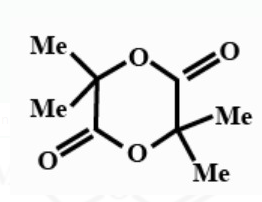An organic compound (A) (C8H14O) forms an oxime and gives a positive haloform reaction. On ozonolysis, it gives acetone and a compound (B) (C5H8O2) . (B) forms a dioxime and on subjecting to oxidation reaction gives an acid (C ) (C4H6O4). On treatment with excess of ammonia and strong heating, (C ) gives a neutral compound (D) (C4H5O2N). (D) on distillation with zinc dust forms pyrrloe. Suggest the possible structures of (A), (B), (C ), and (D). Explain the chemical reactions involved.

Structure of (B):
i. On oxidation, one is lost, so (B) must contain a ⎛⎜
⎜⎝Me−O∣∣C−⎞⎟
⎟⎠ group and aldehyde group.

Topper's Solved these Questions
- ALIPHATIC AND AROMATIC ALDEHYDES AND KETONESBook:CENGAGE CHEMISTRYChapter:ALIPHATIC AND AROMATIC ALDEHYDES AND KETONESExercise:Exercises Concept Application
Explore 20 Videos
- ALIPHATIC AND AROMATIC ALDEHYDES AND KETONESBook:CENGAGE CHEMISTRYChapter:ALIPHATIC AND AROMATIC ALDEHYDES AND KETONESExercise:Exercises Linked Comprehension
Explore 59 Videos
- ALIPHATIC AND AROMATIC ALDEHYDES AND KETONESBook:CENGAGE CHEMISTRYChapter:ALIPHATIC AND AROMATIC ALDEHYDES AND KETONESExercise:Solved Examples
Explore 13 Videos
- ALCOHOL,PHENOL AND ETHERSBook:CENGAGE CHEMISTRYChapter:ALCOHOL,PHENOL AND ETHERSExercise:Archives Analytical And Descriptive
Explore 15 Videos
- AMINESBook:CENGAGE CHEMISTRYChapter:AMINESExercise:QUESTION BANK
Explore 1 Video
Similar Questions
An organic compound (A) , C4H8Cl2 on hydrolysis forms another compound (B) , C4H8O.
If (B) does not responds to iodo form test , then identify possible structures of (A) and (B).
View SolutionAn organic compound A (C7H6Cl2) on treatment with NaOH solution gives another compound B (C7H6O). B on oxidation gives and acid C (C7H6O2) which on treatment with a mixture of conc. HNO3 and H2SO4 gives a compound D (C7H5NO4). B on treatment with conc. NaOH gives a compound E (C7H8O) and C6H5COONa. Deduce the structures of [A], [B], [C], [D] and [E].
View Solution
Knowledge Check
A compound C5H10O(A) forms a phenylhydrazone and gives negative Tollens' test and a positive iodoform reaction. It gives n-pentane on reduction. The compound (A) is
ApentanalB2-pentanoneC3-pentanoneDamyl alcoholThe compound X(C3H6O) on oxidation gives a compound Y(C3H6O2) . The compound Y is
Apropanoic acidBbutyric acidCacetic acidDpropenoic acid
The compound F(C6H12O) on oxidative ozonolysis yirlds acetic acid and a compound (G) (C4H8O3). The new compound (G) on heating gives:A BMe−CH=C=CH−EtC
BMe−CH=C=CH−EtC D
D
Compound (X)C4H8O gives positive haloform test but does not give 2,4 DNP derivation is :
View SolutionCompound (A) C8H9Br, gives a white precipitate when warmed with alcoholic AgNO3. Oxidation of (A) gives an acid (B),C8H6O4. (B) easily forms anhydride on heating. Identify the compound (A)
View SolutionCompound (A), C8H9Br, gives a white precipitate when warmed with alcoholic AgNO3 . Oxidation of (A) gives an acid (B), C8H6O4 . (B) easily forms anhydride on heating. identify the compound (A).
View SolutionCompound (A), C8H9Br, gives a white precipitate when warmed with alcoholic AgNO3. Oxidation of (A) gives an acid (B) C8H6O4. (B) easily forms anhydribe on heating. Identify the compound (A).
View SolutionAn organic compound X(C4H8O2) gives positive test with NaOH and phenopthalein. Structure of X will be :
View Solution

